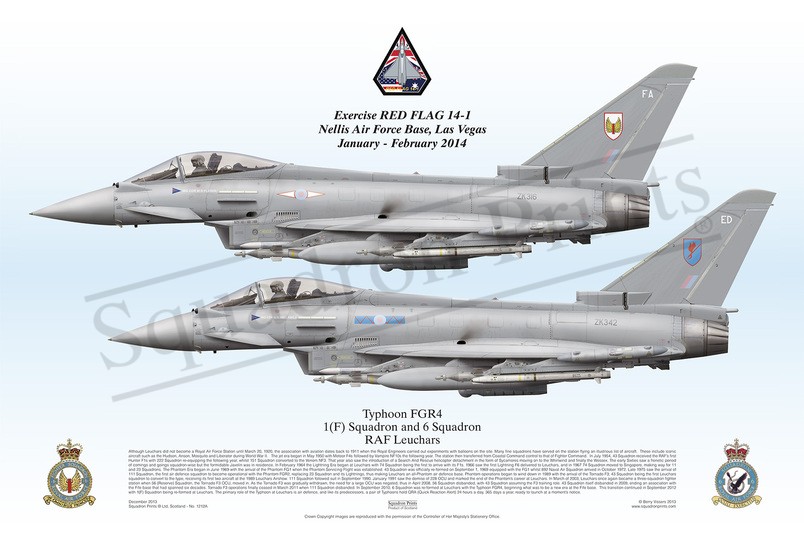#1212A Typhoon FGR4

Purchased products will not feature the Squadron Prints watermark
Description
Squadron Prints Lithograph No. 1212A - Typhoon FGR4, 1(F) Squadron and 6 Squadron, RAF Leuchars. Exercise RED FLAG 14-1, Nellis Air Force Base, Las Vegas, January - February 2014.
Although Leuchars did not become a Royal Air Force Station until March 20, 1920, the association with aviation dates back to 1911 when the Royal Engineers carried out experiments with balloons on the site. Many fine squadrons have served on the station flying an illustrious list of aircraft. These include iconic aircraft such as the Hudson, Anson, Mosquito and Liberator during World War II. The jet era began in May 1950 with Meteor F4s followed by Vampire NF10s the following year. The station then transferred from Coastal Command control to that of Fighter Command. In July 1954, 43 Squadron received the RAF’s first Hunter F1s with 222 Squadron re-equipping the following year, whilst 151 Squadron converted to the Venom NF3. That year also saw the introduction of a Search And Rescue helicopter detachment in the form of Sycamores moving on to the Whirlwind and finally the Wessex. The early Sixties saw a frenetic period of comings and goings squadron-wise but the formidable Javelin was in residence. In February 1964 the Lightning Era began at Leuchars with 74 Squadron being the first to arrive with its F1s. 1966 saw the first Lightning F6 delivered to Leuchars, and in 1967 74 Squadron moved to Singapore, making way for 11 and 23 Squadrons. The Phantom Era began in June 1969 with the arrival of the Phantom FG1 when the Phantom Servicing Flight was established. 43 Squadron was officially re-formed on September 1, 1969 equipped with the FG1 whilst 892 Naval Air Squadron arrived in October 1972. Late 1975 saw the arrival of 111 Squadron, the first air defence squadron to become operational with the Phantom FGR2, replacing 23 Squadron and its Lightnings, thus making Leuchars an all-Phantom air defence base. Phantom operations began to wind down in 1989 with the arrival of the Tornado F3; 43 Squadron being the first Leuchars squadron to convert to the type, receiving its first two aircraft at the 1989 Leuchars Airshow. 111 Squadron followed suit in September 1990. January 1991 saw the demise of 228 OCU and marked the end of the Phantom’s career at Leuchars. In March of 2003, Leuchars once again became a three-squadron fighter station when 56 (Reserve) Squadron, the Tornado F3 OCU, moved in. As the Tornado F3 was gradually withdrawn, the need for a large OCU was negated, thus in April 2008, 56 Squadron disbanded, with 43 Squadron assuming the F3 training role. 43 Squadron itself disbanded in 2009, ending an association with the Fife base that had spanned six decades. Tornado F3 operations finally ceased in March 2011 when 111 Squadron disbanded. In September 2010, 6 Squadron was re-formed at Leuchars with the Typhoon FGR4, beginning what was to be a new era at the Fife base. This transition continued in September 2012 with 1(F) Squadron being re-formed at Leuchars. The primary role of the Typhoon at Leuchars is air defence, and like its predecessors, a pair of Typhoons hold QRA (Quick Reaction Alert) 24 hours a day, 365 days a year, ready to launch at a moment’s notice.
